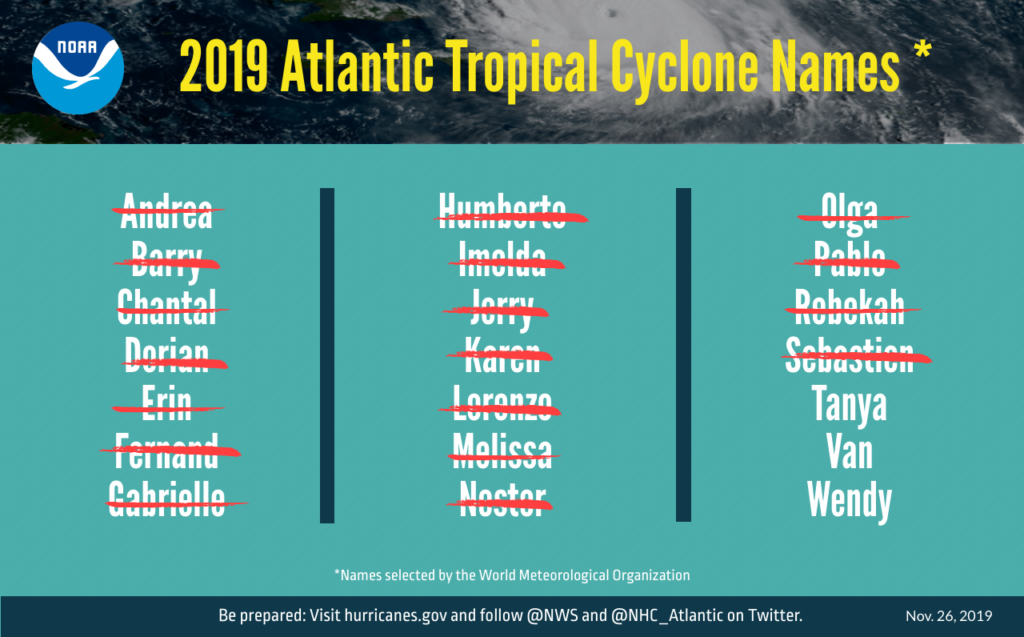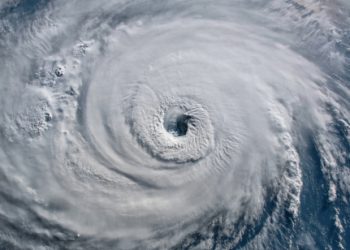The US National Oceanic and Atmospheric Administration advises that the 2019 Atlantic hurricane season which was marked by intensified tropical activity from mid-August through October, comes to an end on Saturday, November 30.
2019 marks the fourth consecutive above-normal Atlantic hurricane season. The only other period on record that produced four consecutive above-normal seasons was in 1998-2001.
Namely, the season produced 18 named storms, including six hurricanes, three of which were “major” of Category 3, 4 or 5. An average season has 12 named storms, six hurricanes, and three major hurricanes.

In addition, this year, five tropical cyclones formed in the Gulf of Mexico, tying a record with 2003 and 1957 for the most storms to form in the region. Of those, Barry, Imelda and Nestor made landfall in the U.S.
The three major hurricanes this season were Dorian, Humberto and Lorenzo. Hurricane Dorian is tied with the 1935 Labor Day Hurricane, 1988’s Hurricane Gilbert and 2005’s Hurricane Wilma as the second strongest hurricane on record in the Atlantic basin in terms of wind with 185 mph.
Overall, the storms Barry, Dorian, Imelda and Nestor made landfall in the U.S. during the 2019 season.
Gerry Bell, Ph.D., lead seasonal hurricane forecaster at NOAA’s Climate Prediction Center said that this season’s activity accelerated during the normal peak of the season, during mid-August, further underlining that
The above-normal activity is consistent with the ongoing high-activity era, driven largely by the Atlantic Multidecadal Oscillation, which entered a warm phase in 1995.
It is further added that “conditions that favored more, stronger, and longer-lasting storms this year included a stronger West African monsoon, warmer Atlantic waters, and weak vertical wind shear across the western Atlantic and Gulf of Mexico.”
NOAA’s outlook which has previously called for 10 to 17 named storms; 5 to 9 hurricanes and 2 to 4 major hurricanes, accurately predicting the overall activity of the season.
Neil Jacobs, Ph.D., acting NOAA administrator said that “the expertise of our forecasters, coupled with upgrades like those to the Global Forecast System model and our next-generation environmental satellites, helped NOAA and its partners save lives and protect property all season long,” highlighting that
NOAA provided around-the-clock support to communities before, during and after each tropical weather threat.
Adding to this, U.S. Secretary of Commerce Wilbur Ross said that
During each and every hurricane season, thousands of workers across the federal government coordinate with NOAA to safeguard Americans against the threat posed by hurricanes.
NOAA notes that during the 2019 season, its hurricane hunter aircraft and crews flew 57 missions over 430 hours, which along with the 53rd Weather Reconnaissance Squadron of the Air Force Reserve, provided critical data that aided in storm forecasting and research.
Also, NOAA’s King Air crew collected more than 26,939 aerial images covering more than 4,300 square miles of areas affected by Hurricane Dorian, including shoreline, ports and impacted inland areas of several Bahamian Islands to help in emergency response.
What is more, NOAA and NOAA-supported researchers from the U.S. and Caribbean deployed 30 autonomous ocean glider missions in the Atlantic, which provided more than 75,000 observations of ocean temperature and salinity to operational hurricane forecast models.
Last but not least, NOAA reports that the 2020 hurricane season will officially begin on June 1 and NOAA’s Climate Prediction Center will provide its initial seasonal outlook in May.
In late 2018, a NOAA research looked at the devastating 2017 Atlantic hurricane season, noting that if similar weather conditions happen in the future, it’s likely the number of major hurricanes to increase by two in a similar active year at the end of century. Climate warming would be the cause of this.
































































